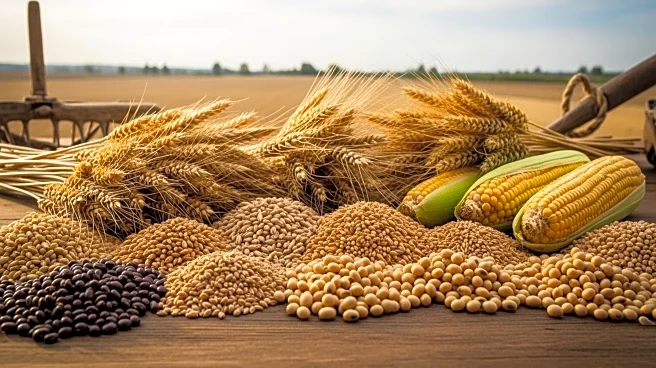What's Happening?
The USDA released its weekly U.S. Export Sales report, revealing mixed results for grain exports. Net U.S. corn export sales for the week ending August 21 totaled 81.6 million bushels, with net cancellations of 700,000 bushels for 2024/2025 delivery. This figure was within trade expectations but lower than the previous week's sales of 111.5 million bushels. Soybean export sales reached 43.4 million bushels, including net cancellations of 7 million bushels for 2024/2025 delivery, surpassing trade expectations. However, China remained absent as a buyer. Wheat export sales were 21.3 million bushels, at the high end of trade expectations and above the previous week's sales. Despite supportive sales data, futures may struggle due to large U.S. wheat and corn supplies.
Why It's Important?
The mixed export sales data is significant for U.S. agriculture markets, influencing grain futures and market positioning. Strong new-crop sales are expected to support corn prices, but the influx of new-crop supplies at harvest could pressure prices. Soybean futures may benefit from supportive sales data, although the absence of China as a buyer could limit gains. Wheat futures face challenges from abundant U.S. supplies, despite supportive sales figures. These dynamics affect farmers' revenue and market strategies, impacting the broader agricultural economy and trade relations.
What's Next?
As the market approaches month-end positioning, traders are preparing for the upcoming WASDE report, which will include more field-collected data. This report, along with actual harvest data expected in the coming weeks, will be crucial for market adjustments. The extended weekend due to Labor Day may also influence trading strategies. Stakeholders will closely monitor these developments to adapt their market positions and anticipate future price movements.
Beyond the Headlines
The absence of China in soybean purchases highlights ongoing trade tensions and their impact on U.S. agricultural exports. This situation underscores the importance of diversifying export markets and strengthening trade relations with other countries. Additionally, the large supplies of wheat and corn reflect challenges in managing production and storage, emphasizing the need for strategic planning in the agricultural sector.












